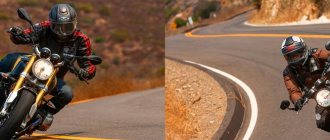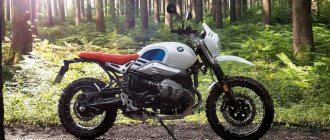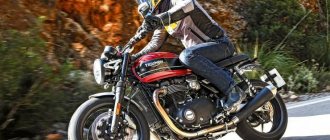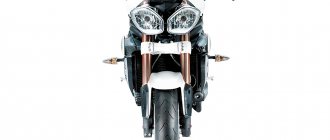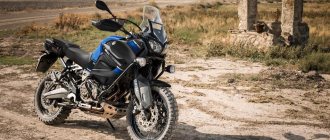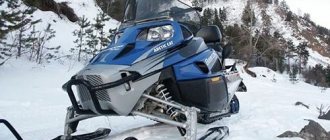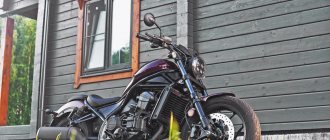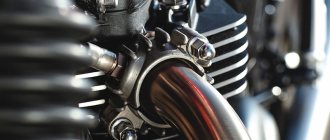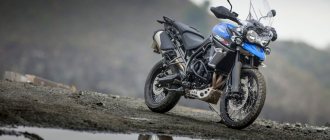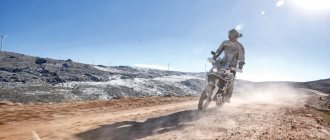BMW R nineT 2021
BMW has published an update to the R nineT line for the 2021 model year. Representatives of the R nineT family received an updated engine that complies with Euro 5 emission standards, a new rear shock absorber, as well as a number of new optional components for customizing the Option 719 series. The 2021 line consists of four models: R nineT, R nineT Pure, R nineT Scrambler and R nineT Urban G/S. The café racer R nineT Racer, unfortunately, was excluded from the line.
Ecological framework of the BMW R nineT 2021
In order to squeeze into a narrower environmental framework, the 1170 cc air-oil-cooled boxer engine that powers the R nineT series motorcycles received new cylinder heads with valve covers, new throttle valves and a new turbulence system that swirls the fuel-air mixture for more efficient and cleaner combustion. The updated engine has a peak power of 109 hp at 7250 rpm, becoming 1 hp weaker than the previous version. The maximum torque value remains at the same level and is 116 Nm at 6000 rpm, but according to the manufacturer, twisting the fuel-air mixture has improved engine performance in the speed range from 4000 to 6000 rpm.
All four R nineT models feature a new rear suspension with variable damping (in BMW parlance this is a progressive damper characteristic) and a new manual spring preload adjuster.
ABS Pro with lean angle tracking is now fitted to all BMW R nineTs, as are the Rain and Road riding modes. Other updates include a new instrument panel, LED lighting and a USB port for charging devices.
The Option 719 catalog of customization components and accessories includes new wheels, milled parts and other decorative elements for every R nineT model, including additional paint options.
Those who have read me more than once know what kind of technique I prefer. But just in case, I’ll explain. In my personal report card, without a doubt and by a large margin from their closest competitors, the leaders are street fighters, predators of the big city, descendants of a sportbike and asphalt disease, well, that’s all, you understand. These miracles of the unhealthy fantasies of the twilight genius can look anything, as long as they are aggressive and brutal. And, most importantly, they must fully justify their name, that is, they must ride in such a way that the rider saddles before his eyes and feels real, genuine, pure fear! An adrenaline generator of the highest standard, so to speak. And a couple of years ago I had the opportunity to briefly own a “factory streetfighter” from BMW (S1000 R), and I had very mixed impressions of it. So today we’ll try another Bavarian motorcycle that claims to be a conqueror of the urban jungle. So, BMW R nine T, let's see if it has the devil's spark.
Here we need to make some lyrical digression. Firstly, the Bavarians never positioned this model as evil or aggressive, placing it in the heritage category, but, on the other hand, this is a BMW, it cannot be sluggish. Secondly, stylistically the Nine T is a cafe racer and does not inspire much fear and awe, and the presence of various versions, from Scrambler to Retro Sport, with a torpedo fairing and a huge number of custom projects rather hint at the so-called open base. That is, we buy an almost empty motorcycle for a minimum price and with a minimum of decor, and then - imagination and customization in all fields.
I won’t hide it, I’ve been eyeing this device for a long time. By itself, especially when you look at it from the side or on the pages of advertising, the motorcycle is quite expressive, with a good classic appearance, which allows you to create from it both a good, suitable retro, and go into neo-futurism, without losing the family features. The number of fairly successful custom bikes of all styles and shapes - from bobbers and scramblers to almost cyberpunk fighters - is a clear confirmation that the original motorcycle turned out to be quite successful. So, the news that there is one in the 2018 press park, and it is free, aroused my serious interest. The device that I got turned out to be something of a compromise option for those who want individuality, but at the same time want all the whistles and horns and other customization to be “from the factory.” Well, yes, there is this type of people: everything that is not done is a collective farm, and at least they have a stake on their head. Yeah, the guys from Brabus smiled mysteriously. And therefore, “option 719” was installed on the motorcycle - this is a set of decorative, milled and gold-anodized aluminum elements designed to make the appearance of the motorcycle individual, while remaining within the framework of the “factory options”.
But we will look at the motorcycle a little later, first the papers and pre-flight briefing. And a rather interesting detail immediately emerges. One of my colleagues who rode a motorcycle before me stopped at a certain Moscow car wash with the intention, oddly enough, to wash the motorcycle. Before filming there or just so as not to return it dirty, it doesn’t matter. It is important that at that car wash the motorcycle was washed with something so vigorous that some gray stains appeared on many parts that cannot be washed off at all. This was especially evident on the parts from option 719, apparently due to the different coating process. Probably, it would be possible to flatten them there with a rasp or emery, but I didn’t dare test this theory on my own equipment. In general, in addition to the usual wishes to return the motorcycle on time, and, preferably, as a single unit, and not as a set of separate parts in different bags and boxes (there were precedents), there was an urgent request either not to wash the motorcycle at all or with soap and water. No harsh detergents! In fact, I don’t know who in their right mind would wash a motorcycle (and a car) with a solution of caustic alkali, and this is exactly what some parts looked like, judging by the damage to the anode layer, but the fact remains a fact.
Well, these are all little things, start the engine, place the butt in the saddle and drive off. Having driven out onto the road, I immediately notice a rather unusual landing. I would find it difficult to call it comfortable or uncomfortable, it’s just different. You seem to be sitting almost straight, with a slight tilt forward, your legs are quite bent at the knees, but your feet are not shifted back. In general, the landing can be described as semi-sporty, a compromise between relaxed-impressive and aggressive-combat. And I won’t say that this is a very successful compromise, I would prefer either the first or the second, but this is completely personal. I would also like to note some asceticism in everything related to controls. Engine mode switch? No. And not even among the options. Switching suspension mode? Forget it. At least the ABS was left in place. Of all the nice things, the only nice thing is the heated grips (optional). Two large dial indicators, tachometer and speedometer. Two small LCD indicators in the center with a bunch of moderately useful information. Fuel level sensor? No, only the reserve light. For BMW this is unheard of asceticism. Thankfully, at least they didn’t consider ABS and the gear indicator to be too futuristic elements and didn’t throw them to hell. However, I was spoiled. In the past, I didn’t even have a tachometer; I could only dream of a fuel reserve light. Why is there a backup light, an electric starter - that was the ultimate dream, otherwise the shamanic dance “Uha-Aha. “Eddle, smoke, start a pile of scrap metal”, performed on kickstarter, sometimes for quite a long time, was not given to everyone and not right away.
However, let’s leave these little things aside and move on to the driving sensations. The motorcycle, as expected from a BMW with a displacement of more than a liter, rides quite cheerfully and maneuvers even more cheerfully. I wouldn’t call it a standard of maneuverability; after all, purebred urban predators will give it a good head start, but you can’t call it a clumsy barge either. In traffic, especially not in catastrophically dense traffic, where the cylinders of the boxer engine protruding to the sides begin to play a certain role in the overall size, the motorcycle feels very good. The suspension, although it does not have a wide range of settings, is still BMW. So, I was pleased with the suspension. Its factory settings were just adequate for Moscow and suburban roads with their “high-quality” road surface. The performance of the suspension and a moderately comfortable saddle make parading in city traffic somehow smoothly like a river – as if you are floating along a Venetian canal to the leisurely song of a gondolier, and all this at speeds of 100 km/h+. I must say, this is a rather pleasant feeling.
The most fantastic property of this motorcycle is revealed at dusk or sunset. And not while driving. Just place it on the footrest near an outdoor cafe so that the rays of the setting sun, the color of ripe Moroccan tangerines, fall on the smooth lines of the outline, polished chrome and black details with gold edging. Fantastic view, so warm and calm. The only thing missing is brown leather as a seat material. Yes, and some chrome parts look like they stand out from the general outline... So, stop. Now the playful hands have already woken up, and the brain has begun to frantically think about what to do with the motorcycle to make it even more beautiful. Actually, that's quite a compliment. Few motorcycles, once in my hands, immediately reveal their potential as the basis for something individual. You often have to think about forms, figure things out, and sometimes, having already started doing something, you have to go back and start over, because the resulting form doesn’t look very good. With this motorcycle everything is different. Michelangelo Buonarroti said that in order to get the perfect sculpture, you need to take a block of marble and cut off all that is unnecessary. So, from the height of my years, I decisively declare that even if you are Michelangelo three times and Buonarroti four times, not every block can produce something worthy. Sometimes you just end up with a shapeless mountain of marble chips. Returning to the motorcycle, we can say that it is exactly the same block, of the same quality, from which even the least experienced Buonarroti is quite capable of producing something for which there will be no shame. The bike looks great anywhere, in any environment, in any light. That's really cool. This is something akin to the notorious magic of Harley-Davidson - some kind of positive energy. The motorcycle attracts the eye, some people like it, some don’t, but it doesn’t leave anyone indifferent.
Now let’s add a huge bucket of tar to this barrel of honey. The first warning sign for me was that at a speed of just over 100 km/h+ I felt somehow amazingly uncomfortable. The engine reached the upper speed range and began to produce some fantastically scary sounds. The last time I heard such a sound was before something stuck to something on my Ural motorcycle and jammed (as it later turned out, due to the complete absence of such an important element in the engine as motor oil), and the one that got out The crankcase connecting rod truly demonstrated the famous “fist of friendship”. I somehow immediately lost the desire to rev the engine above the middle of the range. Well, okay, I think it goes quite well until the middle, about a hundred and a hundred liters again... The second bell for me was how unpretentiously and without tension the ancient Suzuki RF600, like a mammoth crap, drove away from me. 600 Karl! As old as a dinosaur! No, of course he didn’t leave me to the point, he just drove quite cheerfully, and I tried to keep up with him for fucking hundred hundred years. A liter of two hundred versus a little more than half a liter, Karl! I suffered great humiliation extremely rarely. In general, from this moment on, I decided to pay close attention to the dynamics. The conclusions turned out to be very disappointing. The bike rode on par with a Harley-Davidson Sportster Roadster or Triumph Speedmaster. God, have I really lived to see the day when I am forced to compare BMW with Harley-Davidson (and not with the most outstanding representative of the latter). Moreover, if Harley and Triumph can still be forgiven for not having the most outstanding dynamics, then I never expected to see BMW among the motorcycles that are chosen more with the heart than with the mind. The situation was further aggravated by the fact that literally shortly before this I had ridden a BMW R1200GS Adventure, and I had no complaints about its dynamics at all - it pushes like a god (for its size and weight, of course). But these two motorcycles have almost identical engines, and according to factory specifications, the “big goose” is only 10 hp more powerful, but our today’s hero is much lighter... In short, frustration and a mystery in one bottle.
When I returned the motorcycle, I did not fail to ask the local specialists: is it such a bug or feature of the motorcycle that, to put it diplomatically, it does not have the most outstanding dynamic data? To which Boris Lamin, you may know him from the blog “Real Motorcyclist,” said that he personally didn’t notice anything like that, and that at the recent BMW Track Day’s he apparently took a leading place in some category (I don’t remember in some, but definitely not cyclists), and you just had to ignore the sound of the engine and turn it further. I didn’t enter into polemics with Boris, I don’t lay claim to the laurels of a great racer, I still can’t get to those Track Days for some astrological reasons (although I really want to), and Boris, we must give him his due, has experience in driving and owning a BMW is far superior to mine.
Well, I guess I'll finish here. Did I like the motorcycle? Well, let's just say it definitely wasn't a disappointment. Appearance, contours, combination of black and gold, mmmm, delicious. As a platform for all kinds of custom projects, it is practically unrivaled and will give very serious competition to anyone, in any genre. As for the motorcycle itself, this is how it is... Well, you know, I prefer something hotter)))
That's all. Thanks for reading. Peace to you. Drive further and, if possible, harder.
BMW R nineT 2021
BMW R nineT 2021
The base model of the R nineT series is available in Blackstorm metallic with brushed aluminum parts, as well as three Option 719 variants : Night Black matt/Aluminum matt, Mineral White metallic/Aurum and Aluminum. Also available for the model is the Riding Modes Pro option with an additional Dyna mode, dynamic traction control and engine braking control.
Moto-classics: Honda CB1100 EX or BMW R nine T Pure?
In the late 80s, in my father’s garage there hung my poster depicting the unrealizable dream of a Soviet schoolchild - the legendary Honda CB750 motorcycle. Just think, 68 horsepower and 201 km/h! Nowadays this won’t surprise anyone, but the retro theme is in fashion. Who will take me back in time faster - the Honda CB1100 EX or the BMW R nine T Pure?
Almost half a century ago, in 1969, that 750 cc Honda blew up the market and became the true ancestor of modern sportbikes. After all, BMW's engines at that time developed much less: for example, the BMW R75/5 model with a 50-horsepower two-cylinder boxer was capable of accelerating only to 175 km/h. Feel, as they say, the difference.
Now the Bavarian concern's retro series of BMW R nine T can be considered a bridge to the technology of that time - where, like in a good supermarket, the buyer chooses between the options of cafe racers, scramblers and other modern interpretations of cars of the 70s. I took the BMW R nine T Pure for testing - the most honest and real of the entire retro line. A minimum of electronics, extremely “iron” - in other words, a collection of quotes from fifty years ago. True, not on spoked wheels, which its slightly more expensive relatives have. And in general, the R nine T Pure is not so much a replica as a collective image built around a huge boxer engine.
But the Honda CB1100 EX is a different matter. Look how much more elegant, refined, and sophisticated it is than the BMW. The CB1100 EX model debuted in 2010, received an update in 2014 and is also available in the RS version in our market. But we have the “correct” car on test, which most accurately quotes that legendary CB750.
A true classic of instrument making, the electronic odometer only slightly stands out from the general style
A true classic without any “neo” prefixes. The level of detail and the number of direct references to hippie times is simply amazing! The gas tank is teardrop-shaped without a single external weld, the “checkered” seat, and the low “cigar” mufflers. Chrome-plated rims of 18-inch spoked wheels and a rear tire with a bicycle width of only 140 mm, chrome-plated mirror housings and steel (!) side covers under the seat. Instruments - two classic glasses of a speedometer and a tachometer. And only the ABS comb reminds you what year it is.
Why do I write so much about design? Yes, because in motorcycles of this class this is 95% of sales success! Those who need characteristics graze in another field.
• CB1100 EX inline-four is timeless: performance has remained almost unchanged for a quarter of a century • Nissin brake calipers are not the best the CB1100 EX has, but given the vintage tire size, they have plenty of potential
By the way, about the characteristics. With almost similar volumes and two “extra” cylinders, the Honda develops 90 hp, while the BMW engine produces 110 hp. The difference is not fundamental, but power measurements on a dynamometer at AES-Moto revealed an interesting detail. The fact is that the Honda CB1100 EX has a speed limiter set at 180 km/h - according to our measurements, it kicks in at 183 km/h. In principle, this is justified for a direct landing and a complete lack of wind protection. But the problem is that the electronics choke the engine - and at maximum speed the power is limited to 70 horsepower. However, as soon as the speed sensor was turned off, the engine produced 99.3 hp. - by 9.3 hp more official data! In theory, the extra-long sixth gear will allow you to develop as much as 285.2 km/h with such an engine - exclusively on the stand, without taking into account air resistance.
The full version is available only to subscribersSubscribe now
I'm already subscribed
On the run
Let's be honest: overliters are not needed to drive slowly. Both handle this quite well, and it’s interesting how differently: the BMW boxer is an excellent engine, powerful and torquey, but the peak of its capabilities occurs at 3500 rpm. It has an almost automotive character, and it’s not even surprising that it is stubbornly equipped with a single-plate clutch. Due to the longer wheelbase and steering damper, the BMW turns a little less responsively, but it doesn’t wobble at every bump. This is felt on good asphalt, but is especially noticeable on uneven paths.
But the ability to accelerate alone is not enough; you also need to turn and brake. The 320's with radial calipers on the BMW R nineT are much more interesting than the Triumph Speed Twin braking system . Its 305 wheels, however, also stop the motorcycle quite adequately, but, as always, the devil is in the details.
brake system of BMW R nineT and Triumph Speed Twin
But the Triumph Speed Twin has an advantage when driving on small, winding roads. It's shorter, has a shorter fork offset, a higher center of gravity and a narrower rear wheel, so it's much quicker and more willing to turn. Yes, its suspensions do not smooth out bumps as well as the BMW, but they do a good job of keeping the motorcycle on line both in corners and when driving fast in a straight line. The six-speed gearbox and chain drive allow you to shift less often and smoother than the driveshaft on a BMW.
For those who find the Triumph's Sport riding mode too bouncy, there's a Road mode where the response is just as immediate and the traction is excellent right from the bottom. The engine runs smoothly and smoothly, and the seating position is optimal for leisurely rides along the highway.
The steering wheel of the BMW R nineT, in my opinion, is a little wide for a collected position, but despite the more nimble geometry of the Triumph Speed Twin and lower weight, the BMW steers quite on par with it , except that it requires a little more effort for this. On higher-speed sections, BMW could, if desired, overtake Triumph (however, as I already said, in terms of acceleration, their capabilities clearly exceed our needs)
According to the laws of style
The basis for the Bavarian scrambler was the classic BMW R nineT model, which made a lot of noise a couple of years ago and is still one of the brand’s bestsellers. The basis is the most accurate expression that should be used in this case. If you think that the Scrambler is just a nineT restyled and adorned with additional accessories, you are mistaken. These models indeed have a lot in common, but in fact their creators ended up with two completely different motorcycles. Now I will explain why.
BMW R nineT is a niche model. It is designed for nostalgic connoisseurs of classic motorcycles. Moreover, accomplished and wealthy connoisseurs. On the Russian market nineT costs from 1,100,000 rubles. The rather high price, by the way, is completely justified - all the best was used in the design of the motorcycle, no material was cut and no skimp was made on matches. Cool, who would argue! But it was decided to make the Scrambler more widespread, and therefore, inevitably, more accessible. Looking ahead, I will say that costs were reduced wisely, trying not to do harm or spoil anything. In a word, the savings did not come to any harm. Or maybe even the other way around - but this depends on your personal perception of the motorcycle and the requirements for it.
The neoclassic BMW R nineT premiered in 2014. This model was built based on the legendary Bavarian motorcycle R90S exactly for its 40th anniversary. When creating the nineT, BMW focused not on the ultra-modern electronics that all new motorcycles of the brand flaunt, but on impeccable engineering, the highest quality workmanship and high-quality materials. The result was a fairly simple and very “honest” motorcycle, with almost standard driving performance. Moreover, not clouded by all kinds of electronic driver assistants. In the modern motorcycle world, the BMW R nineT occupies about the same place as the classic Swiss “mechanics” in the world of watches.
The first thing that catches your eye when looking at the new BMW Scrambler is the large front wheel compared to the “regular” nineT. Here it is 19 inches, not 17 inches. This makes the brake discs appear smaller, but this is only an illusion. In fact, they are exactly the same and even interchangeable. But the brake mechanisms themselves are different. Instead of expensive radial-mount Brembo monoblocs, the Scrambler uses simpler, collapsible calipers. Also from Brembo, also four-piston, but structurally a little simpler. Can you feel it while driving? Yes, I can feel it. The wheel diameter of a scrambler is larger, which means the load on the brake mechanisms is also greater. Initially, less tenacious, mind you. The result is increased force on the levers and slightly less information content. It’s not critical at all, but if you directly change from one motorcycle to another, it’s noticeable.
The next difference is a different front fork. It is normal here, not inverted, and with a smaller feather diameter: 43 mm versus 46. A little less angle of inclination, a little more reach... But these are the kind of little things that you are more likely to notice on paper, laying out tables of technical characteristics in front of you, than on the road. You can only feel a slightly increased suspension travel. Moreover, not only the front, but also the rear. The difference, compared to the “basic” model, is small - about 5 mm, but when driving on bad roads, for which the scrambler is generally designed, they will definitely not be superfluous!
It turns out there is a difference in the frame design. Honestly, standing next to the motorcycle, I wouldn't have noticed it. Fortunately, there was someone to ask - directly from the chief manager of the Scrambler project who accompanied us during the test. It turned out that some expensive cast elements were replaced with welded ones, and it consists not of four elements, as on the nineT, but of three. As a result, it will not be possible to completely remove the entire rear part of the frame on a scrambler. Although, why remove it? This may only be required by professional customizers when seriously modifying a motorcycle. For everyone else, it’s enough that the “tail” remains removable, and the Scrambler, like the nineT, can be turned into a single-seater by installing a shorter seat.
The saddle itself, by the way, is quite high here. If you check the technical specifications again, it will turn out to be four centimeters higher than on the nineT. This is also another signature feature of all scramblers - the pilot’s seat should be high and vertical. On the BMW Scrambler, this is also facilitated by the rather high steering wheel. You sit behind him, really, straight and comfortably. About the same as on touring motorcycles of the GS series. Now, only the footrests here are clearly too high. The legs are strongly bent at the knees, stronger than on the nineT. And it’s also unlikely that you’ll be able to hit the asphalt with the running board while turning. At least on all the BMW Scramblers that I happened to see during the test, there were no characteristic “notches” on the running boards!
The saddle, and on our motorcycles it was single (this is an option), looks very cool, but still worse than on the concept already mentioned at the beginning. I understand - mass production. The stylish cross stitching was replaced with simple stampings. It looks like it from a distance, but not so much up close. But it’s comfortable to sit, unless, of course, you try to spend eight hours in a row in the saddle. For this class of motorcycles, this is normal. I don’t think anyone would regard the scrambler as a serious long-range weapon. He is not fit for such feats. So, our test mileage was 200-300 km per day and, getting off the motorcycle, I did not feel any discomfort in any part of the body. Including the one you’re probably thinking about right now!
